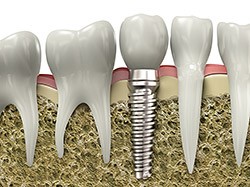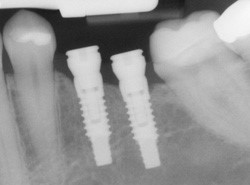Regular brushing, flossing, and checkups allow many people to maintain their natural smiles for their entire lives. However, sometimes teeth still fail. If you have lost one or more teeth due to injury, decay or gum disease, dental implants could rejuvenate both your smile, your ability to chew and your oral health.
An implant is a tooth root in the shape of a post that is surgically placed into the jawbone below the gum line. It is usually made of titanium, the same material used in many replacement hips and knees, and a metal well suited to pairing with human bone. The post fuses with your jawbone becoming a very stable support for the artificial teeth.
The replacement teeth are made to match your natural teeth and mounted on top of the post. An individual tooth, a group of artificial teeth (a bridge), or an entire denture can be attached to the dental posts. The teeth can be either permanently attached or removable. Permanent teeth are more stable and feel more like natural teeth.


